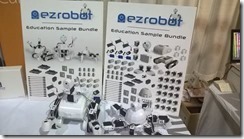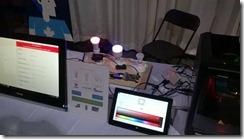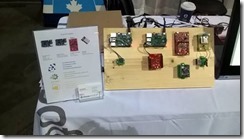Be ready for Maker Faire: The final report
For the second time I got a chance to participate in Vancouver Mini Maker Faire. You can find my previous report here.
This year we decided to avoid any entertainment activities and build our demos around the most interesting technologies for makers. So, people could find the following demos visiting our booth:
· Lots of robots from our good friends – EZ-Robot;
· Home automation demo that shows Windows 10 IoT Core abilities to manage lots of smart devices;
· Azure IoT Services in action;
· Bluetooth Low Energy support in Windows 10;
Let’s discuss each of these demos in details.
Everybody like robots! That’s why EZ-Robot booth was the most popular place among children and their parents. EZ-Robot is founded in Calgary and allows you to learn robotics using lots of hardware and software tools. You can start with EZ-B controller and build your own robot using any motors and sensors or you can buy a ready-to-use robot kit. Once you assemble your robot, you can use innovative EZ-Builder tool in order to develop software even without coding at all. Advanced developers can find lots of SDKs, including SDK for Windows 10 Universal applications. Don’t miss our interview with EZ-Robot and cool demos at the end:
In the second demo we showed, how to use Windows 10 IoT Core on Raspberry Pi 2 in order to build a home automation system. Windows 10 supports AllJoyn as well as AllJoyn API that you can use in order to create Windows 10 applications. But, if we are talking about home automation, you can find lots of ZigBee and Z-Wave but not AllJoyn devices. But it’s not a problem at all. You can simply use our bridges for AllJoyn and use the same API in order to work with any device in your home. So, if you are looking for a hub for your smart home, you can easy use Win 10 IoT Core, Rapberry, C# and Visual Studio in order to create anything.
In the next demo we showed several Azure IoT services. In order to avoid questions “why Raspberry” and “why C# and Windows 10” I installed four different micro boards: Raspberry (Linux/NodeJS), Raspberry (Windows/C#), ESP8266 (Arduino) and CC3200 Launchpad (TI RTOS/C). Thanks to Azure IoT SDK, you can use C, C#, Python, JavaScript and Java in order to connect anything to Azure. I used three services: IoT Hub for device management and messaging, Stream Analytics for real-time analytics and Power BI for real-time dashboard. In my next articles I am going to share more details.
Finally, in order to show Windows 10 connectivity features, I decided to build an application that shows how to work with Bluetooth Low Energy devices. I selected the sensor tag device from Texas Instruments but you can use anything. Later, I am going to publish the project to github but it’s really easy.
Here are couple images from the event:


